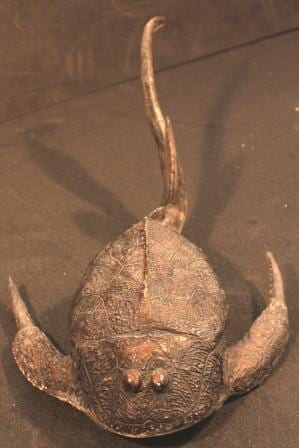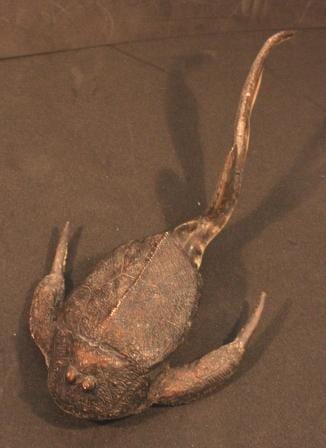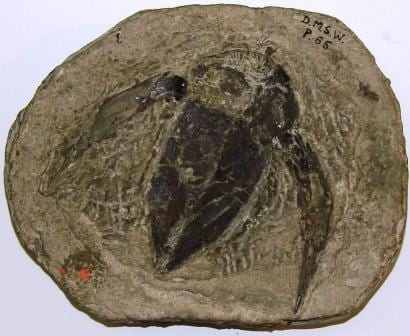Specimen of the Week: Week Eighty-Seven
By Emma-Louise Nicholls, on 10 June 2013
 As with most people, I have a number of different passions. Be it, palaeontology/zoology, or films, or board games, or buying new socks, I enjoy a great many things and dedicate a serious amount of time to each. Most time of course goes to palaeontology/zoology, in so much as I am in fact paid to do that for a living (WAHOOOO). But sometimes I feel as though I may have been neglecting an area and get the urge to go back to the roots of a hobby and give it a little TLC. When I think back to the roots of palaeontology, being the single most continuous love in my life, I remember writing an essay ‘back in the day’ on a particular fossil animal, of which we have a fantastic reconstruction in the Museum. It sits nonchalantly and unassuming in a corner but when you hear a little about it, I think you’ll get the urge to make a special journey. This week’s Specimen of the Week is…
As with most people, I have a number of different passions. Be it, palaeontology/zoology, or films, or board games, or buying new socks, I enjoy a great many things and dedicate a serious amount of time to each. Most time of course goes to palaeontology/zoology, in so much as I am in fact paid to do that for a living (WAHOOOO). But sometimes I feel as though I may have been neglecting an area and get the urge to go back to the roots of a hobby and give it a little TLC. When I think back to the roots of palaeontology, being the single most continuous love in my life, I remember writing an essay ‘back in the day’ on a particular fossil animal, of which we have a fantastic reconstruction in the Museum. It sits nonchalantly and unassuming in a corner but when you hear a little about it, I think you’ll get the urge to make a special journey. This week’s Specimen of the Week is…
**The Bothriolepis**
1) Bothriolepis is an extinct genus of placoderm fish, which is a fancy word that means ‘plated skin’, a bit like a living, swimming tank. All placoderm fishes had this thick-bone-filled skin that served as armour against anything that may have felt as though they looked good to eat. The name Bothriolepis in fact means ‘trench scale’. Although it made them heavier, this natural armour plating was a hugely great idea as it served as fantastic protection. At least, it would have done had Bothriolepis not been lazy in its dermal armour production and distribution as although the head and body were heavily armoured, the tail was left rather more vulnerable with only a covering of scales to fend off pesky predators. The pectoral, or front set of fins were broad and flat in order to provide lift and to propel Bothriolepis and its heavy armour plating up into the water column.
2) It may have been lazy at armour production but it was certainly prolific at speciation; i.e. evolving into different species. Botheriolepis diverged into over 100 known species, and between them they spread throughout the world. In fact, specimens of Bothriolepis are so widespread and numerous that scientists believe it to have been one of the most successful placoderm fishes to have ever lived. Well done that fish.
3) Bothriolepis lived during the Devonian period, which for people who think that all fossils are dinosaurs, may find a bit world-shattering. The Devonian period started around 420 million years ago, by comparison, the dinosaurs evolved a mere 250 (ish) million years ago. Pah.
4) Bothriolepis grew up to 30 cm in total body length, including the tail. Many specimens have been found with sediment in the gut, which has lead Scientists to conclude that it was a detritivore; i.e. fed upon detritus material. To find food with this life habit, Bothriolepis would sit upon the substrate, sifting through the mud and silt for organic material. Backing up this theory is the spiral shaped gut, which is found in modern detritivores. This type of gut creates a longer pathway from the mouth to the anus which is thought to give the animal more time to digest nutrients from the food as the detritus material spends longer within the internal organs.
5) Some scientists believe that Bothriolepis was a fish with mega skills (rough translation) and as such was able to survive out of water. As well as the normal fishy gills Bothriolepis had ‘pouches’ that connected to its oesophagus. This may have acted as a rudimentary set of lungs meaning that Bothriolepis would have been capable of breathing air and surviving out of water for short periods of time. True or not, the strong pectoral fins (shown in the image on the left) would certainly have been capable of pushing the heavy fish along when on land.
Emma-Louise Nicholls is the Museum Assistant at the Grant Museum of Zoology
One Response to “Specimen of the Week: Week Eighty-Seven”
- 1
 Close
Close






[…] are born equal. This isn’t true. Some fossil fish are born, then die, then get fossilised to wow and impress. Suffice to say that not all fossil fish can be superstars, opening shopping centres, turning on […]